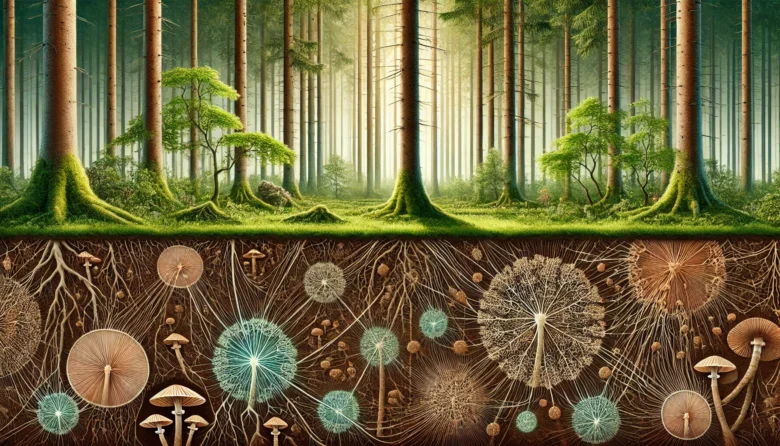When we think of forests, we often picture towering trees, lush undergrowth, and the vibrant tapestry of life that fills these spaces. But beneath the surface, a hidden world of connections and cooperation plays an essential role in keeping these ecosystems thriving. This world is shaped by the mycorrhizal networks—an underground web of fungal threads that connect plants and trees, enabling them to share resources, communicate, and support one another in ways that seem almost magical.
Introduction: Unveiling the Underground Networks
Imagine a forest as a bustling city. The trees are the buildings, the plants are the people, and the mycorrhizal networks are the roads, bridges, and communication systems that link everything together. Without these networks, the forest would struggle to survive. In this blog, we’ll delve into the fascinating world of mycorrhizal networks, exploring how they function, their critical role in forest ecosystems, and why they are vital for the health of our planet.
What Are Mycorrhizal Networks?
Mycorrhizal networks, also known as the “Wood Wide Web,” are formed by a symbiotic relationship between fungi and plant roots. The word “mycorrhiza” is derived from the Greek terms “myco,” which means fungus, and “rhiza,” which means root. These networks are created when fungal hyphae (thread-like structures) extend from the roots of a plant, connecting with the roots of other plants and trees, sometimes spanning entire forests. This intricate web allows for the transfer of water, nutrients, and even information between plants.
Mycorrhizal networks primarily consist of two types: arbuscular mycorrhizae (AM) and ectomycorrhizae (EM). AM is common in grasses and herbaceous plants, while EM is typically found in forests, especially in association with trees like pines, oaks, and beeches. Both types play a crucial role in forest ecosystems, but their mechanisms and interactions with plants differ slightly.

The Benefits of Mycorrhizal Networks
Nutrient Exchange and Sharing:
One of the most significant benefits of mycorrhizal networks is their ability to facilitate the exchange of nutrients between plants. Fungi are exceptionally adept at drawing minerals such as phosphorus and nitrogen from the soil. They then trade these nutrients with plants in exchange for carbohydrates, which plants produce through photosynthesis. This exchange is mutually beneficial, helping both the fungi and the plants thrive in environments where nutrients might otherwise be scarce.
Communication and Warning Systems:
Mycorrhizal networks also serve as a communication system for plants. Through these networks, plants can send chemical signals to warn each other of potential threats, such as insect infestations or disease. For example, if a tree is attacked by aphids, it can release chemical signals into the mycorrhizal network, alerting neighbouring trees to ramp up their defences. This kind of inter-plant communication helps to protect the forest as a whole.
Support During Stress:
In times of environmental stress, such as drought, mycorrhizal networks can play a critical role in helping plants survive. Through these networks, plants can share water and nutrients with struggling neighbours, ensuring that the entire community remains resilient. In some cases, larger and healthier trees have been known to support smaller, younger plants through these underground connections, giving them a better chance of survival.
Biodiversity and Ecosystem Stability:
Mycorrhizal networks contribute to the overall biodiversity and stability of forest ecosystems. By facilitating nutrient exchange and enhancing plant health, these networks help to create a more diverse and resilient plant community. This, in turn, fosters a diverse array of other species, ranging from insects to mammals, resulting in a well-balanced and flourishing ecosystem.
Case Studies: Mycorrhizal Networks in Action
The Douglas Fir and Paper Birch Connection:
One of the most famous examples of mycorrhizal networks at work comes from research conducted in the forests of British Columbia, Canada. Studies have shown that Douglas fir trees and paper birch trees are connected through mycorrhizal networks, allowing them to share resources. During the summer, when the paper birch has an abundance of leaves and sunlight, it shares some of its carbon with the Douglas fir. In return, during the fall, when the birch loses its leaves, the fir shares its stored nutrients with the birch. This reciprocal relationship helps both species thrive in their shared environment.
The Role of Mycorrhizae in Tropical Rainforests:
In the Amazon rainforest, mycorrhizal networks are crucial for the survival of the diverse plant life found there. The nutrient-poor soils of the rainforest mean that plants rely heavily on these networks to obtain the minerals they need to grow. Research has shown that trees connected to extensive mycorrhizal networks are more likely to survive and thrive, even in the face of deforestation and other environmental challenges.
The Impact of Human Activity on Mycorrhizal Networks
Regrettably, crucial networks like these have been disrupted by human activities, including deforestation, urban development, and industrial farming. When forests are cleared, the mycorrhizal networks that once connected the trees and plants are destroyed. This not only impacts the plants directly but also affects the entire ecosystem, including the animals and microorganisms that depend on healthy forests.
Efforts to restore forests often overlook the importance of re-establishing these underground networks. However, some conservation projects are beginning to recognize the role of mycorrhizae in forest recovery. By reintroducing mycorrhizal fungi into reforested areas, these projects aim to rebuild the critical connections that sustain healthy forests.
Conclusion: Nurturing the Web of Life
Mycorrhizal networks are the unsung heroes of forest ecosystems. These hidden webs of life connect plants and trees in ways that are vital for their survival, enabling them to share resources, communicate, and support one another. As we continue to confront environmental issues like climate change and deforestation, it is more important than ever to understand and protect these essential networks.
Next time you walk through a forest, take a moment to appreciate the invisible connections beneath your feet. The health of our forests, and ultimately our planet, depends on these remarkable mycorrhizal networks.
Author’s Note
As someone deeply passionate about environmental science, I find the study of mycorrhizal networks to be a fascinating glimpse into the complexity of nature. Understanding these hidden connections gives us a greater appreciation for the interdependence of life on Earth.
G.C., Ecosociosphere contributor.




